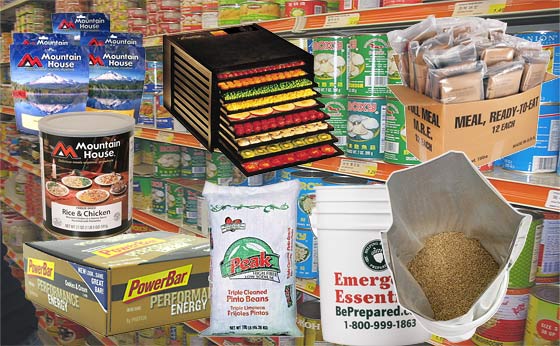Pros – Cons of Freeze-Dried, Dehydrated, Canned, Grains, Legumes
A pros and cons list of the various methods and types of food for deep pantry storage that you may consider in your overall diversified preparedness plan.
Freeze-Dried Food
Pros
Long shelf life.
Very lightweight.
Very low moisture.
Reconstitutes quickly.
Best way to dry meat items.
Excellent nutritional retainment.
Generally tastes better than dehydrated.
Individual meal choices ideal for backpack.
Retains original shape, texture, color after reconstitution.
Cons
Most expensive food storage option.
Most items require water to prepare.
Items are bulkier than if dehydrated.
If purchased in Mylar pouches, susceptible to puncture.
Read more: Dehydrated vs. Freeze Dried Foods
Dehydrated Food
Pros
Low moisture (not as dry as freeze dried).
Lightweight (not as light as freeze dried).
Long shelf life (not as long as freeze dried).
You can do it yourself with a home dehydrator.
Cons
Requires water to prepare.
Some items have poor visual appeal.
May lose some taste after reconstitution.
Some items take a long time to reconstitute.
Read more: Dehydrated Food Shelf Life
MRE (Meal Ready to Eat)
Pros
Convenient to use.
Familiar foods available.
Requires no water to prepare.
No mixing or blending required.
Simple to add in a backpack, kit.
Can be heated for hot meal by many methods.
MRE’s taste better these days than they used to.
Can be eaten right from pouch without preparation.
Cons
Not intended for long term consumption.
Taste of MREs considered less than ideal by some.
Lots of sodium (needed for long term viability).
Artificial additives added in many recipes.
Expensive considering actual food received.
Entrees alone will not supply adequate nutritional value.
Because of foil pouch, they are susceptible to puncture.
Can be heavy if larger quantities need to be transported.
Read more: MRE Meals for Food Storage & Survival Kit
Commercially Canned Food
Pros
Wide variety of canned foods.
Secure packaging – containment.
Lots of inexpensive choices.
Readily available at all grocery stores.
Moderate shelf life, generally 3-years – depending.
‘Real’ shelf life often much longer than posted without issues.
Cons
Heavier than dried foods.
Difficulty in freezing conditions.
May have lots of sodium (for shelf life).
Typically lots of preservatives, other additives.
Not as practical for on-the-go or carrying.
Exposure to water and humidity promotes rust.
Read more: Canned Food Groups for Preparedness
Home Canned Food
Pros
Long shelf life.
Lots of recipes.
No refrigeration required.
Something you can do yourself.
Tremendous options of what you may ‘can’.
Excellent method towards self sufficiency.
Cons
Time consuming process.
Initial cost of jars, lids.
Glass jars, heavy, breakable.
Read more: 12 Lifesaving Home Canning Rules
Emergency Food Bars
Pros
Low cost.
Calorie dense
About 1yr shelf life.
Compact – convenient.
Good for portability – small kit, quick calories.
Cons
Limited nutritional value.
Not everyone likes the taste.
Inadequate for prolonged use.
Not a satisfying substitute for a hot meal.
Read more: The Clif Bar – Great Energy Food Bar
Grains, Beans, Basic Commodities
Pros
Low cost.
Good nutritional value with variety.
The basic food staples – very important.
Very long storage life if stored properly.
Essential ingredients for sustaining life.
Many sprout-able seeds, grains, and beans increase nutritional value.
Cons
More time consuming to prepare.
Heavy weight – meant for storage, not portability.
Not generally appropriate for shorter term emergencies.
Time is required to adapt to basic commodity oriented diet.
Requires relatively large quantities of water and fuel to prepare.
For calories, a fairly large quantity must be consumed when eaten exclusively.
Read more: Calories Per Pound Of Rice, Beans, Wheat
SUMMARY
There is more to this… Within each category there are some food items that offer more “pros” then the others in their group.
For example rice. White rice is easy to prepare, can be combined with almost anything to make a delicious meal and is cheap, easy to store and has a great weight to calorie ratio. Powdered or flaked potatoes have a similar list of advantages.
Rice & Beans – A Survival Combination
Variety and diversification are important for a good overall food storage plan.
The partial list above should give you some ideas to consider.
You might check out what Bob has over at ReadyMadeResources. Not only does he carry a wide variety of supplies, but food kits too.

